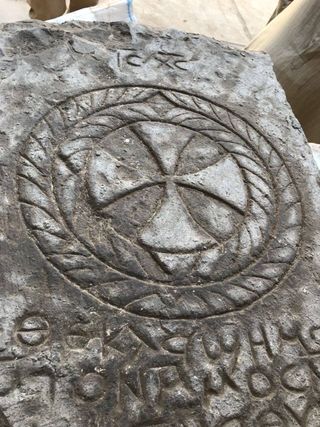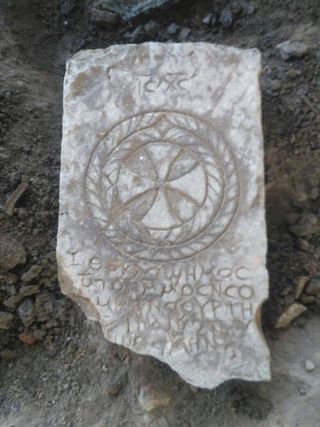Ancient Coptic Tombstone Found Along Egypt's Avenue of Sphinxes

Archaeologists unearthed an ancient Coptic tombstone during a dig Sunday (Oct. 22), according to Egypt's antiquities ministry.
The tombstone is decorated with a cross and Coptic inscriptions that were carved onto a limestone block, the ministry said. It measures about 1.2 feet by 3 feet (38 by 98 centimeters).
It wasn't immediately clear for whom the gravestone was made or when it was produced, but archaeologists plan to study it more to find out, Mostafa Alsager, the general director of Karnak Antiquities and the Avenue of Sphinxes, said in a statement. [Photos: 2,000-Year-Old Tombs Found in Egyptian Oasis]
The tombstone was discovered by an Egyptian archaeological group that was excavating beneath the Al Mathan bridge in Luxor, on the eastern side of the Avenue of Sphinxes — a well-known historical road that is lined with small sphinxes.

These days, Coptic Christians make up just 5 to 10 percent of Egypt's population, but the majority of Egyptians used to be Coptic, according to Paul Rowe, a professor of political and international studies at Trinity Western University in British Columbia, Canada.
The word "Copt" comes from an ancient Greek word that means "Egyptian," and it's used to refer to all Egyptian Christians, Rowe said.
According to the biblical book of Acts, Jews from Egypt visited Jerusalem for the feast of Pentecost, a harvest festival that marked the birth of the Christian church just weeks after Jesus' crucifixion, Rowe said. These Egyptians took the Christian message back to their homes, which started the Coptic tradition.
Sign up for the Live Science daily newsletter now
Get the world’s most fascinating discoveries delivered straight to your inbox.
The majority of Egyptians were Christian by the fourth century, but a few hundred years later, during the Middle Ages, Egyptians began to convert to Islam, Rowe said.
The discovery of the limestone tombstone may help archaeologists learn more about the ancient Coptic people who lived in Egypt, the ministry said.
Original article on Live Science.

Laura is the archaeology and Life's Little Mysteries editor at Live Science. She also reports on general science, including paleontology. Her work has appeared in The New York Times, Scholastic, Popular Science and Spectrum, a site on autism research. She has won multiple awards from the Society of Professional Journalists and the Washington Newspaper Publishers Association for her reporting at a weekly newspaper near Seattle. Laura holds a bachelor's degree in English literature and psychology from Washington University in St. Louis and a master's degree in science writing from NYU.
Most Popular


